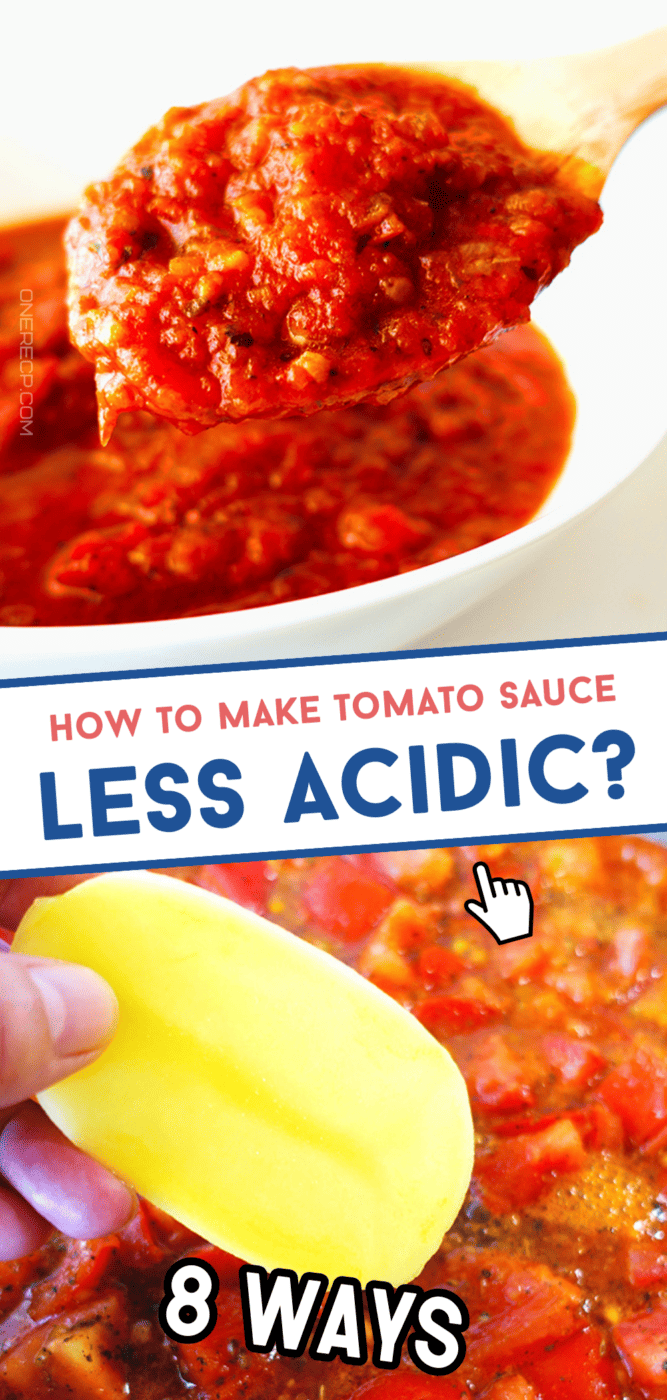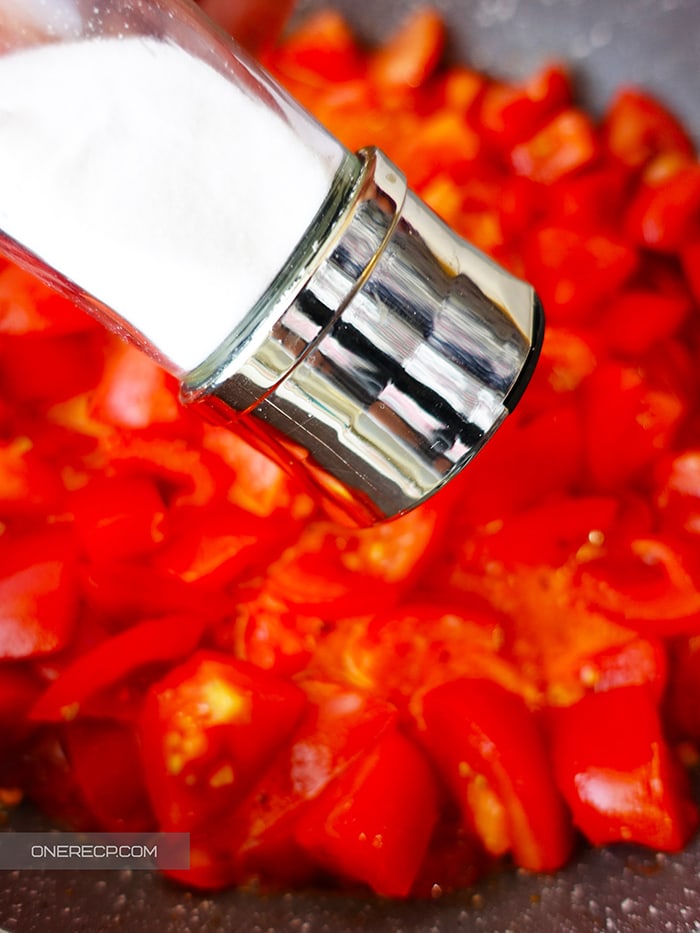Whether you’re serving it with pasta or on your pizza, a good marinara sauce should never taste sour.
Fortunately, there are plenty of ways to make tomato sauce less acidic without ruining its flavor.
You can add sugar, increase cooking time, or even use a potato to absorb some of the acidity.
In this article, I’ll show you how to use eight different methods that can make your passata less tangy.
Let’s dig in.

How to make tomato sauce less acidic?
Before we continue, I should clarify that some of the methods are used to balance out the flavors and don’t lower the pH of the sauce itself.
Reducing the acidity in tomato sauce can only be done by adding an alkaline substance that will neutralize the uric acid in the tomatoes.
And despite what many online sources claim, there are very few ingredients that fit into this category.
With that said, it’s time to take a look at how you can cut the acid in tomato sauce.
Add a pinch of baking soda

One of the few ways to actually reduce the acidity of tomato sauce is by adding baking soda.
Baking soda is an alkaline substance so it will react to the uric acid in the tomatoes and cut their acidity.
However, you should be careful since using too much can make your sauce taste flat.
If by any chance you add too much baking soda in your spaghetti sauce, you can squeeze some lemon juice or add vinegar to balance out the flavor. In most cases, a 1/4 teaspoon of baking soda is enough to lower the acidity of tomato sauce, without ruining its flavor.
Increase cooking time

If you’ve browsed through your fair share of tomato sauce recipes, then you’ve probably noticed some of them call for a longer cooking time.
And as it turns out, there’s a pretty valid reason for this.
Simmering tomatoes for more than an hour lets the uric acid in tomato seeds evaporate, which reduces the sour taste and acidity of the sauce.
Since tomato seeds also contain more liquid, they need to be for longer to fully get rid of the uric acid. However, this method will only work if you’re using fresh tomatoes since canned varieties come without any seeds.
It’s also worth pointing out that if you cook the sauce for longer it will have a thicker texture.
Use quality tomatoes

Whether you’re working with fresh or canned tomatoes, picking the right type can have a dramatic effect on the acidity of your sauce. Most tomato cultivars are typically on the lower end of the pH scale with a value of just 4.3.
However, fleshier types of tomatoes such as the San Marzano, can have a pH of 4.6 which makes them less acidic. If you’re using fresh tomatoes, you can further decrease their acidity by removing the skin and seeds.
Another thing you should consider is whether to use fresh or canned tomatoes.
Most canned tomato manufacturers use citric acid to help preserve the quality of the tomatoes.
So if you want to make a non-acid tomato sauce, you should stick to fresh, ripe tomatoes.
Add sugar

Adding sugar to tomato sauce is probably the oldest and most popular way for “cutting” acidity.
However, despite what many cooking gurus might proclaim, sugar doesn’t lower acidity in any way.
It simply tricks your taste buds by balancing the sour and sweet tastes of the tomatoes.
Nevertheless, if you don’t have any gastrointestinal issues such as heartburn, you can still take advantage of this and make your sauce less sour. I’ve found that 1/2 teaspoon of sugar is usually enough to “cut” the acid out of a 28-ounce batch of tomato sauce.
Don’t leave out the salt

If by any chance you’ve decided to make your tomato sauce without any salt, then it might be a good idea to reconsider.
Even though it may seem odd, salt can actually help bring out the sweetness of the tomatoes. In fact, according to studies, salt is responsible for transporting glucose to the sweet receptors in our tongue.
Similarly to using sugar, this method counteracts the sour taste of the tomatoes, without lowering their pH.
Add carrots

Adding carrots to your tomato sauce is a great way to make it taste more savory and cut down its acidity.
Carrots are rich in natural sugars that can turn around the otherwise acidic taste of tomato sauce.
Moreover, carrots are also a great source of fiber so using them will improve the texture of your sauce.
Finish the sauce with some butter or cream

Butter is a common ingredient in many classic sauces such as Bechamel, Bearnaise, and Hollandaise.
However, most marinara sauce recipes are made without butter and use olive oil instead. The good news is you can use unsalted butter to finish off your tomato sauce and make it less sour.
Moreover, butter has a higher pH than tomatoes so it will effectively neutralize their acidity once it dissolves. Anyways, using 2 tablespoons of unsalted butter should be enough to make your tomato sauce less acidic.
Add a potato

Even though it may seem strange, adding half a potato to your tomato sauce can also lower its acidity.
However, this method isn’t nearly as efficient as some online sources claim it to be.
The reasoning behind this technique is that the potato will soak up the acidity from the tomatoes once it gets boiled.
Unfortunately, this is only partially true since potatoes absorb some of the liquid they were boiled in, but not acids themselves. So to achieve the desired effect, you’ll actually need to replenish the water that’s absorbed by the potato.
Which amounts to only 10% of its net weight.
Author’s note: Another common misconception about potatoes is that they can make dishes less salty. This is only true for soups, since potatoes are made of 80% water and adding them essentially softens the effect of salt on the palate.
As you can see, this method isn’t really practical, but I decided to include it since many people still believe that potatoes act as an acid sponge.
In case you still decide to give it a try, you should peel a reasonably fresh potato first and simmer it along with the tomato sauce.
Once your sauce is ready, let it rest for 10 minutes, then discard the potato and add the water.
Suggested read: Are red potatoes just dyed?
What’s the best tomato variety for a marinara sauce?
To choose the best type of tomato for your low-acid marinara sauce, you should look for fleshier tomatoes with less water content.
Some of the best tomato varieties that fit this description are Italian sorts such as San Marzano, Roma, and Regina.
You can also use Amish paste tomatoes since they have a similar texture and shape to the aforementioned varieties.
I personally prefer using San Marzano since they’re readily available at most local stores and groceries.
Whichever sort you end up choosing, you shouldn’t forget to remove their seeds and skin since they contain the highest amount of uric acid.
My Conclusion
The secret to a great tomato sauce is learning how to manage its acidity.
And this can be achieved with nothing more than high quality tomatoes, and a pinch of baking soda.
Be sure to share your experience with acidic foods or acid-free tomato sauce recipes down below by leaving me a comment.
Hi. Liked your article. I really need to cut down on acid. I would like to try the baking soda method, however, the article doesn’t say how much tomato sauce you are adding the 1/4 tsp of baking soda to. Later, you mention a 28 oz jar for the sugar. Is that your assumption for the baking soda as well?
Hey,
Here’s a recipe for a low-acid tomato sauce:
INGREDIENTS:
1.8 pounds San Marzano tomatoes (preferably fresh; if you’re using canned – that’s a 28 oz can of tomatoes)
1/4 cup finely grated celery
1 cup finely grated carrots
1 tbsp tomato paste
3 tbsp olive oil
3 finely chopped cloves garlic (optional)
1/2 cup water
1 tsp baking soda
1 1/2 tsp salt
1/2 teaspoon paprika flakes
1 tsp dried oregano
1 tsp dried basil
INSTRUCTIONS:
1. Saute the crushed garlic and tomato paste in a large skillet pan over medium-high heat.
2. Crush the tomatoes in a large bowl.
3. Add the tomatoes along with the rest of the ingredients to the pan.
4. Simmer the sauce for approximately 30 minutes.
NOTES: If you’re doing this with canned tomatoes instead you can use the following conversion:
A 28-oz can of tomatoes is equivalent to approximately 2 pounds of tomatoes, which is usually 10 to 12 fresh tomatoes.
Hope this helps
Thank you. I will try it. Must admit I usually buy jarred sauce. I will use your proportions as a guide.
I use the pre-simmer with peeled potatoes, seems to work.
‘My 1st time making Chicken Cacciatore! After eating a bowl, I soon after had trouble with the acidity. (Pepto!)
You have so much helpful info here; I’ve learned so much of what I did wrong. ~The canned sauce I used not only had seeds, but was watery. ~The recipe said to cook it 30 min., so I didn’t cook it down. ~(& just to add… I used white wine thinking it’s milder & found it’s actually more acidic than red!) I’ll be trying the baking soda when I reheat it.
I’m ESPECIALLY appreciative of the thorough, calm, easy-read explanations following each topic. I thank you SO much for your time in “laying it all out for us.” 🙂
Thank you for the kind words Gin! The food acidity rabbit hole can be unforgiving sometimes… 🙂